+ データを開く
データを開く
- 基本情報
基本情報
| 登録情報 | データベース: PDB / ID: 3f9q | ||||||
|---|---|---|---|---|---|---|---|
| タイトル | Re-refinement of uncomplexed plasmepsin II from Plasmodium falciparum. | ||||||
 要素 要素 | Plasmepsin-2 | ||||||
 キーワード キーワード | HYDROLASE / Aspartyl protease / Glycoprotein / Protease / Vacuole / Zymogen | ||||||
| 機能・相同性 |  機能・相同性情報 機能・相同性情報cytostome / plasmepsin II / acquisition of nutrients from host / vacuolar lumen / food vacuole / vacuolar membrane / aspartic-type endopeptidase activity / proteolysis 類似検索 - 分子機能 | ||||||
| 生物種 |  | ||||||
| 手法 |  X線回折 / X線回折 /  シンクロトロン / シンクロトロン /  分子置換 / 解像度: 1.9 Å 分子置換 / 解像度: 1.9 Å | ||||||
 データ登録者 データ登録者 | Robbins, A.H. / Mckenna, R. | ||||||
 引用 引用 |  ジャーナル: Acta Crystallogr.,Sect.D / 年: 2009 ジャーナル: Acta Crystallogr.,Sect.D / 年: 2009タイトル: Crystallographic evidence for noncoplanar catalytic aspartic acids in plasmepsin II resides in the Protein Data Bank. 著者: Robbins, A.H. / Dunn, B.M. / Agbandje-McKenna, M. / McKenna, R. #1:  ジャーナル: J.Mol.Biol. / 年: 2003 ジャーナル: J.Mol.Biol. / 年: 2003タイトル: Novel uncomplexed and complexed structures of plasmepsin II, an aspartic protease from Plasmodium falciparum. 著者: Asojo, O.A. / Gulnik, S.V. / Afonina, E. / Yu, B. / Ellman, J.A. / Haque, T.S. / Silva, A.M. | ||||||
| 履歴 |
|
- 構造の表示
構造の表示
| 構造ビューア | 分子:  Molmil Molmil Jmol/JSmol Jmol/JSmol |
|---|
- ダウンロードとリンク
ダウンロードとリンク
- ダウンロード
ダウンロード
| PDBx/mmCIF形式 |  3f9q.cif.gz 3f9q.cif.gz | 80.8 KB | 表示 |  PDBx/mmCIF形式 PDBx/mmCIF形式 |
|---|---|---|---|---|
| PDB形式 |  pdb3f9q.ent.gz pdb3f9q.ent.gz | 60.2 KB | 表示 |  PDB形式 PDB形式 |
| PDBx/mmJSON形式 |  3f9q.json.gz 3f9q.json.gz | ツリー表示 |  PDBx/mmJSON形式 PDBx/mmJSON形式 | |
| その他 |  その他のダウンロード その他のダウンロード |
-検証レポート
| 文書・要旨 |  3f9q_validation.pdf.gz 3f9q_validation.pdf.gz | 427 KB | 表示 |  wwPDB検証レポート wwPDB検証レポート |
|---|---|---|---|---|
| 文書・詳細版 |  3f9q_full_validation.pdf.gz 3f9q_full_validation.pdf.gz | 432.7 KB | 表示 | |
| XML形式データ |  3f9q_validation.xml.gz 3f9q_validation.xml.gz | 16.1 KB | 表示 | |
| CIF形式データ |  3f9q_validation.cif.gz 3f9q_validation.cif.gz | 23 KB | 表示 | |
| アーカイブディレクトリ |  https://data.pdbj.org/pub/pdb/validation_reports/f9/3f9q https://data.pdbj.org/pub/pdb/validation_reports/f9/3f9q ftp://data.pdbj.org/pub/pdb/validation_reports/f9/3f9q ftp://data.pdbj.org/pub/pdb/validation_reports/f9/3f9q | HTTPS FTP |
-関連構造データ
| 関連構造データ |  1lf4S S: 精密化の開始モデル |
|---|---|
| 類似構造データ |
- リンク
リンク
- 集合体
集合体
| 登録構造単位 | 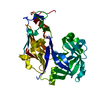
| ||||||||
|---|---|---|---|---|---|---|---|---|---|
| 1 | 
| ||||||||
| 単位格子 |
| ||||||||
| Components on special symmetry positions |
| ||||||||
| 詳細 | 1 |
- 要素
要素
| #1: タンパク質 | 分子量: 36909.617 Da / 分子数: 1 / 変異: M205S / 由来タイプ: 組換発現 由来: (組換発現)  発現宿主:  |
|---|---|
| #2: 水 | ChemComp-HOH / |
| Has protein modification | Y |
-実験情報
-実験
| 実験 | 手法:  X線回折 X線回折 |
|---|
- 試料調製
試料調製
| 結晶 | マシュー密度: 2.46 Å3/Da / 溶媒含有率: 50.04 % |
|---|
-データ収集
| 放射光源 | 由来:  シンクロトロン / サイト: シンクロトロン / サイト:  NSLS NSLS  / ビームライン: X9B / 波長: 0.92 Å / ビームライン: X9B / 波長: 0.92 Å |
|---|---|
| 放射 | プロトコル: SINGLE WAVELENGTH / 単色(M)・ラウエ(L): M / 散乱光タイプ: x-ray |
| 放射波長 | 波長: 0.92 Å / 相対比: 1 |
| 反射 | 解像度: 1.7→19.8 Å / Num. obs: 29457 / Observed criterion σ(F): 0 |
- 解析
解析
| ソフトウェア | 名称: CNS / バージョン: 1.2 / 分類: 精密化 | |||||||||||||||||||||||||
|---|---|---|---|---|---|---|---|---|---|---|---|---|---|---|---|---|---|---|---|---|---|---|---|---|---|---|
| 精密化 | 構造決定の手法:  分子置換 分子置換開始モデル: PDB entry 1LF4 解像度: 1.9→19.8 Å / 交差検証法: THROUGHOUT / σ(F): 0 / 立体化学のターゲット値: Engh & Huber
| |||||||||||||||||||||||||
| 原子変位パラメータ |
| |||||||||||||||||||||||||
| Refine analyze |
| |||||||||||||||||||||||||
| 精密化ステップ | サイクル: LAST / 解像度: 1.9→19.8 Å
| |||||||||||||||||||||||||
| 拘束条件 |
|
 ムービー
ムービー コントローラー
コントローラー





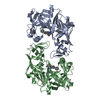
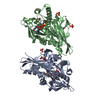
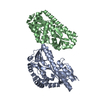


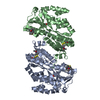
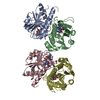
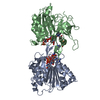
 PDBj
PDBj
